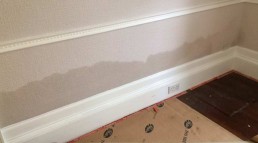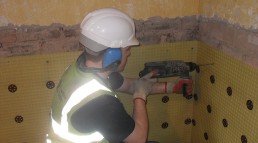Treating Rising Damp
There are various options available to combat rising damp, however the most commonly used is the installation of a damp-proof course. This procedure causes a barrier to be formed, preventing moisture from rising up the wall due to capillarity. All properties built today have a damp-proof course installed, however this seemingly essential feature is often absent in some older properties.
To complement a damp-proof course, we also sometimes install a damp proof membrane, which is applied directly to the wall. This membrane prevents any moisture penetration within the specific area, further protecting against rising damp.

Ground level management is also a procedure you might have heard about for treating a rising damp problem; however, it is far less cost-efficient than the installation of a damp-proof course and the application of a waterproof membrane. At Richardson & Starling, we rarely suggest this method, as we believe it will not deliver a guaranteed solution.
If you suspect you have a rising damp problem, one of our highly experiences specialists will be able to attend your property and diagnose any damp related issue. The appropriate solutions can then be specified to fix the problem and prevent rising damp from occurring again and affecting the walls treated.
Inserting a Damp-Proof Course
The most commonly used option for fixing the problem of rising damp is the insertion of a damp-proof course. This is a cost-effective way of combatting the issue, as repairs are highly localised and can be completed internally.
Damp-proof course installation is a process whereby waterproof material is injected into walls, with the intention of creating an unbroken barrier to moisture. This prevents moisture from traveling up the wall and affecting the property and internal decoration, allowing your property to dry out and stay that way.
In order to carry out the installation of a damp-proof course, we will first remove all skirting boards and contaminated plaster. We will then drill a number of holes into the affected area, before injecting a waterproofing cream solution. If appropriate a damp proofing membrane is applied to the walls then re-plastered and left ready to be decorated.

If you believe that your property already contains a damp proof course but are still suffering from rising damp, this could mean that your DPC is bridged or damaged. Your damp proof course can be perforated by tree roots or it can be bridged by raised ground levels to your property.
Should there be an issue with rising damp in a property that already has a damp-proof course, our surveyor will be able to identify the problem and then specify the most effective solution.
Installation of a Damp Proof Membrane
The application of a damp proof membrane is sometimes carried out in conjunction with the most popular rising damp treatment method – installation of a damp proof course. The process is a simple one, but highly effective at preventing future occurrences of damp affecting the inside fabric of your property.
The installation of a damp proof membrane is a simple process. Once a damp-proof course has been installed, the area is then covered with the membrane, forming another barrier against moisture. The wall can then be plastered and decorated as normal.
Many preservation companies use only one damp proofing method. Here at Richardson & Starling, we believe that the combination of both methods may be required to provide a long-lasting solution and allow the wall to dry out quicker. It is because all our damp proofing solutions are specific to the individual property and damp problem that exists that we are confident to support our works with long-term guarantees up to 30 years.

Exterior Ground Level Management
Rising damp can also be caused by an external factor, such as the level of the ground outside the property being too high and bridging the existing damp proof course. The damp proof course should be a minimum of 150 mm above the ground outside.
As already mentioned, exterior ground level management is an expensive process and one that is rarely needed. It involves the removal of all ground above or close to the damp proof course, which will prevent moisture from the ground or rain being able to access an unprotected area of the wall.
If possible, the ground level should be lowered however if this cannot be done then a new damp proof course can be inserted. You can find more information about rising damp treatment on our FAQ page.
Specialists in the Detection and Treatment of Rising Damp
With over 85 years of experience, we are specialists at detecting and treating rising damp in properties. If you believe you have an issue with rising damp, one of our professionals will be able to visit your property and advise you on the most effective way to solve the problem. What is more, our remedial treatment for rising damp is covered with a 30 year guarantee supported by the GPI scheme, for your peace of mind.
If you have any questions regarding damp affecting your property, please contact your local branch for free advice or a property survey.